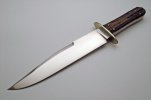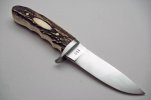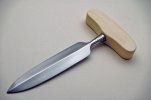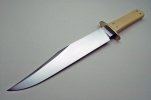Two weeks ago, my good friend, Ron Lockhart advised me that he is thinning out his fine collection of primarily Bowie knives and I decided to ask him about the availability of his "grail" DE Henry Schively Bowie which he had obtained a few years ago from Nordic Knives. I knew it was a knife he had long cherished and was thrilled to own but fortunately, he decided to part with the knife. Here is the basics of this particular knife. OAL 16" with 11" blade likely of D2 steel made in the mid '70's. This knife is rather unique because it was one of DE Henry's personal knives. Ron advises that this is known because his own name is on the escutcheon whereas when knives were built for customers had the customer's name engraved on the escutcheon.
Ron also created a nice bit of info that folks may be happy to read to learn more about one of the iconic knifemakers from the past.
" DE Henry
Legendary Bowie Knife Maker
Daniel Edward Henry
1924-1993
In the early 1950's, the Custom Knife renaissance was just in it's infancy with a handfull of makers like WF Moran, Bo Randal, Rudy Ruana, Scagel and DE (Ed) Henry, developing the sytles and techniques that furture knifemakers would follow. This ws the "pre-dawn" period of custom knifemaking as we know it today.
Henry actually makes his first knife in 1943 while a Marine stationed on a navy transport ship. Back home his interest continued to grow and by the early 1950's he began making his first Bowie knives --- later to be know as his "First Generation". These knives were influenced by the prevailing Bowie concerpts of the time, --- big, clunky, heavy blades with large brass lugged crossguards similar to the Randall Smithsonian Bowie. In all, 55 knives were numbered in this "First Generation".
By the mid 1950's, an important transformation occurred --- Henry met famed Bowie collector, dealer and authority Robert Abels in New York. He had the opportunity to view and study authentic Bowie knives from the 19th Century. "Nobody knew anything about Bowies in those days" were his own words.
This was the beginning of the Henry "Second Generation" of Bowie knives patterned after historical 19th Century Sheffield models. "He taught us what Bowie knife should look like" commented J.R< Edmondson, noted Bowie author and historian. Henry continually studied and researched his subject.
It is from this time that the Henry Legend would take off and the manyy "firsts" that he introduced would evolve. It is quite a list:
1. First maker to flat grind his blades (1943)
2. First to do a hand stin rubbed lateral finish -- no power buffing
3. First to serial number his knives. The only exceptions were a small number of prototypes and a fe wmade as his own personal knives.
4. First to grind 440C chromium alloy steel (1960)
5. First to use stainless for guards on his hunting knives.
6. First maker to be associated with the bowie knife and first to fully research authentic Bowie patterns.
7. First to reporduce Sheffield 19th Century Bowies with traditional scabbards mounted with nickel silver tips, throats and frog studs (1955)
8. First to inlay nickel silver escutcheon plates (1956)
9. First to use stainless for the mounts on his Sheffield scabbards (1976)
It was in this period that his hallmarks of quality and workmanship became fully realized. Every bevel was crisp, symmetrical and absolutely true. Every jucntion was meticulously fitted. He educated both collectors and fellow knifemakers about authentic Bowie knife patterns.
Hew viewed the knife as an art form unto itself and not a canvas for garish embellishment. He "transformed a craft into ta legitimate art form" and established the standards of qualtity that all makers would strive to emulate.
His knives were rich in the history of the 19th Century but their true significance would be their inflkuence in both design and quality on the history of 20th Century (and beyond) custom knifemaking.
By 1968, Henry had moved to his 3 1/2 acre home and shop in the foothills of California gold rush country on a high ridge overlooking the tiny community of Mountain Ranch. Here, in the solitude he enjoyed, his knifemaking would flourish.
In 1971, he introduced his "Third Generation" of Bowies patterned after pre Civil War American knives and named for American wildlife. Names like "Old Lobo", "Old Grizzly", etc.
In 1974, his "Fourth Generation" was begun, influenced by straight back "Rezin" style blades and those of the Philadelphia cutler, Henry Schively, featuring a false upper bevel cut on one side of the blade only. These Bowies, named after historical sites of Texas history include "Bejar", "San Saba", "Conception" etc.
By this time, his fame was well established and wait times stretched to 6-7 years with the final price based on market conditions at the time of completion.
The final series, his "Fifth Generation" arrived in the early 1980's and was patterned after th e19th Cenury San Francisco Bowies made famous by makers like Will & Finck and Michael Price with names from that period.
In all, his producion was limited to 466 knives make over a 40 year career. The time consuming hand work often exceeded 100 hours limiting the number of finished knives to 10 or 12 per year.
He was fiercely individualistic self taught, self styled maverick, often described as àrrogant, eccentric, ego centric and antagonistic`but he was also cpable of genuine warmth with those he respected and his wife and son whom he dearly loved. With health issues starting to become a problem, Henry retired from knifemaking in 1991 and after a battle with illness passed away in 1993.
His importance and influence both on the delvelopment of custom knifemaking and the understanding of historical Bowie knives cannot be over emphasized. The legend of D.E. Henry lives on in the classic knives he created in his ground breaking career,."
The Schively Bowie at its listed price was $800 but may have sold for more at the time due to DE's policy as his career advanced of charging current prices on his orders that had a 7 year waiting period.
 But his knives are one of those things that have been burned in my memories for decades since I was a boy.
But his knives are one of those things that have been burned in my memories for decades since I was a boy.






